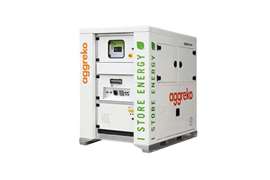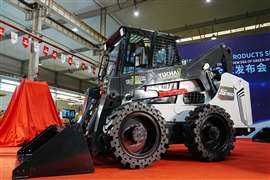Drilling: Saving energy and boosting productivity
09 February 2012
.gif)
Manufacturers in the drilling sector are responding to demand from both regulators and contractors for more energy efficient and environmentally sensitive equipment, and new technology is playing a big role.
From state-of-the art silencing hoods to load-sensing hydraulics, the sophistication of drilling equipment is increasing whether for whole drill rigs or individual drill bits.
The drilling sector is being affected by the introduction of stricter emissions regulations in Europe and the US. The European Stage III B and US Tier 4 Interim legislation applied to engines rated 130 kW to 560 kW at the start of 2011 - a band which impacts on many of the power systems used to drive drill rigs, while rigs powered by engines ranging from 56 kW to 130 kW must comply with Stage IIIB/ Tier 4 Interim legislation from this year.
In general terms, the 2012 laws that apply to the lower power band would affect surface rigs capable of drilling holes with a diameter of around 3 in (76 mm) or less. The 2011 emissions laws for higher powered engines would generally apply to larger surface rigs capable of drilling holes above 3 in (76 mm) in diameter.
But it is not just the physical changes to the engines that are having an impact - an industry-wide shift in attitude is also taking place. Atlas Copco product line manager for surface drill rigs Olav Kvist told iC that the new laws had led to a revolution in energy efficiency for the company's new SmartROC T35/T40 drill rigs.
"We developed a totally new way of delivering energy," Mr Kvist said. "The new design automatically regulates the amount of energy required for each function, optimising the power supply to the components."
Mr Kvist said the T35 and T40 drill rigs have achieved up to -50% cuts in fuel consumption during testing in Sweden, Norway, Germany, Poland and Turkey. He said the Caterpillar C7.1 Stage IIIB engines also produce a 25 kg to 30 kg per engine hour less CO2 emissions and offer a 95% average availability.
A new hydraulic system was also developed that requires -50% fewer hoses and -70% fewer couplings, resulting in an average -65% reduction in hydraulic oil usage - a drop that has resulted in a much smaller hydraulic oil tank.
"The rigs have really been fine-tuned so that the engine is always running at maximum efficiency for the task at hand - the compressor can be closed down when it is not needed, for instance," Mr Kvist said.
"The new emissions regulations are driving this key trend towards energy efficiency. Because of the nature of drilling, hybrid energy recovery is not possible - there is not much breaking force to reclaim energy from, for instance - and it's all about controlling logistics and shaving off the corners."
In addition to the new engines, the T35 and T40 rigs have also been updated with a new silencer kits to meet environmental demands for quieter drilling.
Supplied as an option, the hood reduces the noise generated from the feed by 12 dB(A) using a double layer of noise absorbent material together with an upgraded aluminium chassis that has greater resistance to drill rod vibration.
Without the silencer kit, the specified noise level of the SmartROC T35 and T40 is 127 dB(A) at peak power, while the hood results in a noise level of 115 dB(A).
Mr Kvist said use of the noise reduction kit on urban construction sites could make contractors more likely to be regarded as preferred suppliers. "The real noise source is the drill rod. We reduced this noise considerably with the first silence kit and now we have done it again by a further 2 dB(A), which sets a new standard on the market."
Sound-proofing was also a major consideration for Italian manufacturer Casagrande when it upgraded its C6 crawler drilling rig. The new C6 XP model is fitted with a sound-proofed bonnet which is said to reduce noise emissions by half compared to the previous version.
But it is the drive to save energy that is again at the heart of this new machine, and Casagrande introduced new load-sensing hydraulics to the XP version which are said to result in fuel consumption savings of up to 25%.
Powered by a Stage IIIA-compliant, 94 kW Deutz TCD 2012 engine, the C6 XP was developed for micro-piling, anchor drilling and jet grouting, and is available in both a manual hydraulic and radio-controlled version.
Its improved jointing also allows work to be done next to walls and the machine has been equipped with new sliding lattice extensions that can reach a depth of 18 m in jet grouting mode. The new C6 XP articulation system also allows the rig to reach extreme and demanding positions - it can work in very tight spaces up to a 30° maximum negative angle, for instance.
The company has also introduced new rotary drilling heads for the C6 XP - the T14EP and T20EP models. Energy is also a key consideration here, and the new models boast electro-proportional control which allows revs and torque to be varied and gearings to be set according to the characteristics of the job.
Meanwhile, sophisticated energy saving features were also central to the design of Sandvik's DI550 down-the-hole (DTH) drill rig, which was first showcased at Bauma 2010 and has now gone into full production.
Equipped with a 328 kW Tier 4 engine for sale in Europe and North America, the machine is said to perform efficiently and economically thanks to features such as its highly-developed flushing control system, intelligent compressor air pressure control, advanced dust collection control and smart tramming control.
Sandvik said its customers had reported productivity improvements of up to 30% compared to other rigs in the same class.
Maximising potential
Accuracy and productivity are also key demands when it comes to drill bits, and Sandvik concentrated on maximising the potential of rigs when it developed its new Uniface drill bit and GT60 tube system.
"The performance of the drill rig is only as good as the delivery tube and the tools and bits it uses," the manufacturer said, claiming that compared with traditional designs, the new Uniface bit - which has a patented face design - offers improved distribution of energy and more efficient flushing.
Indeed, Sandvik said that it had recorded deviations below 2% on straight hole drilling using the GT60 tube system and Uniface bits, and achieved this "much faster than any other drilling system in the world today."
Sandvik Uniface bits with ballistic buttons are available from 51 mm up to 115 mm to suit Sandvik R32, T35, T38, T45, T51 and GT60 extension rods.
The Uniface drill bit is said to be wear and breakage resistant, enhanced by the extra toughness of the Sandvik-produced cemented carbide, while the GT60 tube system is said to ensure exactness of delivery using a new thread design and tailored drill steel dimensions.
And the new bit and tube systems are not only compatible with Sandvik rock drill - they can be used with the typical piston size and power of other drills possessing similar performance.
Reducing operating costs is a key driver behind new developments in bit design, and Rockmore International has also launched a new product - the B6, which is said to prolong bit life and increase drilling penetration rates.
Designed for hard rock drilling and blasting operations in tunnelling, the B6 has a head diameter of 45 mm to suit the most popular tunnelling blast hole dimension, and its button bit has six large tungsten carbide inserts on the periphery row for enhanced rock breaking.
The carbide inserts are about 1 mm larger in diameter compared to previous models, leading to longer bit life.
The B6 also incorporates many changes in flushing design, such as placement of grooves and flutes designed to carry the rock cuttings away from the bit face.
Multiple flutes have been placed strategically between all button inserts in order to maximise the flow of the flushing medium - an enhancement Rockmore said contributed to increased penetration rates since the rock cuttings evacuate the drilled hole more efficiently.
The size and scope of urban construction projects is also influencing the development of new drilling technology. Italian manufacturer Soilmec, for instance, widened its micro drilling range with the launch of a new rig dedicated to operating in confined sub-soil spaces - the SM-3.
The rig has crawlers that can expand from 780 mm to 1.1 m, and features outriggers, telescopic zoom and 15o mast tilting. The machine's slew ring can also work in an area of +/-180° and, despite its compact dimensions, the rig can be equipped with a range of rotary heads with torque values of up to 9000 Nm for different drilling requirements.
The SM-3's modular mast also allows it to have three different strokes for 1, 1.5 and 2 m-long rods. The main unit comes with a separate power pack (75 kW electric or up to 115 kW diesel) that is also equipped with expandable crawlers.
The micro drilling rig is said to be well-suited for work inside buildings and tunnels, and can also be used with grouting rods of up to 90 mm diameter.
Technology is driving change in all aspects of the drilling sector, and machine guidance is another key area that manufacturers are pursuing to increase accuracy and reduce instances of human error.
For instance, Sandvik developed a new advanced navigation system for surface drilling. The 3D system, TIM3D, uses satellite navigation to guide the starting point and the correct course of drilling in accordance with pre-programmed project plans.
Sandvik claims the system, which is compatible with the US GPS and Russian GLONASS satellite systems, improves drilling accuracy significantly in quarrying, construction and open pit mining applications.
The system compares the position of the drill bit with the planned hole position and guides the operator to the correct starting point of the chosen hole.
During drilling, the operator can follow the penetration rate and hole depth, distance to target, number of required holes and current feed alignment. Drilling stops automatically at the target depth, while local base station, or VRS correction, keeps navigation accuracy within 100 mm.
Consolidation has changed the face of the drilling equipment sector over the last year, and 2012 looks set to be a competitive environment. With emissions regulations a driving force behind new machine launches in Europe and the US, more and more sophisticated and environmentally sensitive equipment can be expected for these markets.
But strong demand is also present in developing markets with lower or no emissions standards, and it will be interesting to see how drilling equipment manufacturers deal with this two-tier dynamic in the future.






